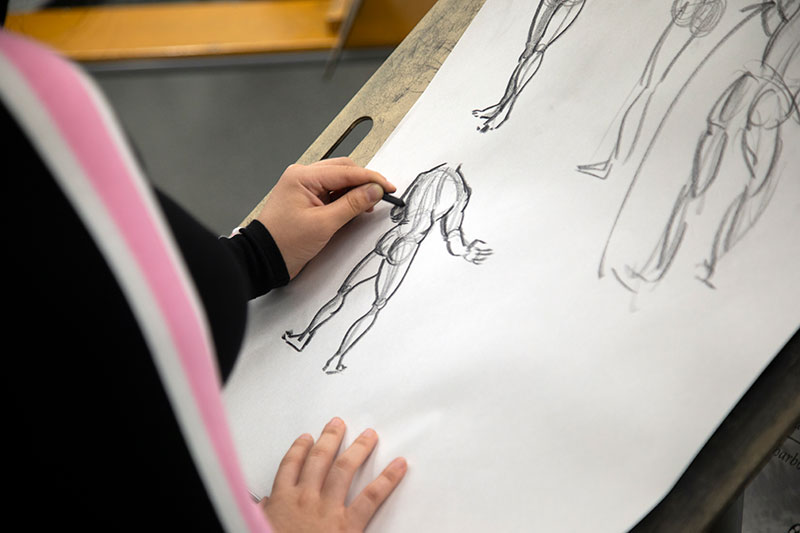Submit an online application to Capilano University, this is required before you submit your portfolio.
Applicants must submit their portfolio through the online portal SlideRoom.
upload to SlideRoom
Your portfolio should consist of 15–24 images. There are specific areas that you should cover in terms of what you are drawing. These areas, in order of importance, are:
- Life drawing
We'll look for your ability to draw the human form accurately. This means proper proportions. Also, the more you draw, the more confident your line will look. Show structure as well as the outline.
- Sketches of people (about as important as life drawing)
This will consist of drawings of a wide variety of people at rest, at work, at play. Again, go for drawing accuracy. Sketches may be long studies of people at rest or quick "memory" drawings (where you quickly grasp the essential lines of a figure in motion and "fill it out" after the person has moved on). The best places for sketchbook drawing are cafes, airports, markets, skateboard parks, buses...anywhere you can find a lot of people doing different things.
- Sketches of locations (there can be people in the drawings too)
This shows us again, your ability to draw from life but also shows us your perspective drawing. Places that are interesting or challenging for you to draw: architecture, staircases, exteriors, interiors, technical drawings (a motorcycle parked at the curb or a bicycle against a gate...etc.).
- Life drawing of animals
Rather than draw an entire zoo, just pick two or three different animals and really get to know them well. Learn their anatomy and proportions, then sketch them in different poses or from different angles.
- Your "cartoony" stuff
Original character designs, doodles, comics and cartoons. Best to show a variety of styles. Creating two or three characters that fit the same style is good. Once you have a character, draw them in different situations...falling down, climbing a ladder, getting attacked by a little dog, etc.
- Anything else you think would support your application
Animation or motion graphics, 3D work, fine art, experimental work. While not as important as the first five categories, feel free to post miscellaneous work to your online portfolio.
- Animation experience
If you have work experience in animation or have taken courses elsewhere, or if you have a specific interest that would help your application, feel free to write it in the comments section of the online portfolio submission form.
Traditional and hand-drawn work should be scanned. If you don't have access to a scanner check your local library or school. In a pinch a digital camera will work, however, the quality will likely not be as good due to lighting issues (like using a flash). Photographing artwork on an overcast day without a flash will give better results.
Once you create your account in SlideRoom you can begin uploading your portfolio and other requirements. Take your time; you may edit your submission as much as you like but remember that we can review it only after you click the SUBMIT button!
What not to include in your portfolio
Originality is vital. Do not submit work that is not your own. If you have to include drawings you made from an anatomy book or any kind of group project, make sure you label what is not yours and whose work it is. If we see work that is not yours but looks like you're trying to pass it off as yours, it will reflect poorly on the whole portfolio.
Drawing from photographs is less impressive than drawings from life because, with a photo, much of the work is done for you already (and it usually looks flat and lifeless anyway). If you have to send us drawings you copied from photos, make sure you still have lots of examples of life drawing and sketchbook work.
Good Luck!
Important Dates and Deadlines
Fall 2026
- Apply to Capilano University before submitting your portfolio to SlideRoom.
- Portfolios submitted without a corresponding University program application will not be reviewed.
- The deadline for uploading a portfolio is 11:59 p.m. on March 10, 2026.
- Only portfolios uploaded to SlideRoom will be reviewed.
Applicants are encouraged to attend one of our free open house sessions before applying in order to see the facilities, talk to students, observe their work and ask questions about our programs.



